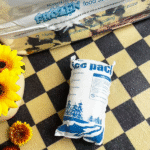La mejor bolsa de hielo seco: Cómo elegir en 2025
Actualizado: Octubre 13, 2025
Finding the best dry ice ice pack starts with safety and ends with predictability. En la primera caja que empacas, asegurar desfogue, correcto UN1845 labeling for air, y un ajuste que mantiene los productos congelados sin rupturas ni reelaboraciones. Reducirás las pérdidas, pasar controles de aceptación, y envíe con confianza, carril tras carril.
-
How does the best dry ice ice pack prevent bursts and pass checks?
-
How much dry ice or gel do you need for 24–72 horas?
-
¿Qué materiales, espesores, y los caminos de ventilación funcionan mejor en carriles reales?
-
¿Cuándo el gel/PCM es la mejor opción que el hielo seco para objetivos refrigerados??
-
Qué 2025 las innovaciones importan: respiraderos inteligentes, monomateriales, y validación digital?
What makes the best dry ice ice pack safer and compliant?
Respuesta corta: Desfogue, adaptar, y durabilidad. El best dry ice ice pack always includes a controlled vent path, uses a bag that fits the block or pellets without over-sealing, and survives drops and vibration in automation. Los paquetes no deben ser herméticos., and inner bags are doblado, no sellado—a pass/fail detail on acceptance checklists.
Por qué esto te importa: Dry ice sublimes and produces gas. A sealed bag traps pressure and can rupture, damage the shipper, or fail acceptance. The safest standard pack uses vent-friendly inner bags y un vented outer shipper, marcado UN1845 with net weight for air. That one change reduces rework and claims dramatically on frozen lanes.
Material choices for the best dry ice ice pack
| Material | Barrera | Vent behavior | Durabilidad | Lo que significa para ti |
|---|---|---|---|---|
| HDPE 5–6 mil | Medio | Equilibrado | Alto | Robust in automation, good all-rounder. |
| LDPE 4–5 mil | Med-low | Bien | Flexible | Easier handling; still needs fold-vent. |
| Metallized/mylar | Alto | Low without vents | muy alto | Use only with micro-vents or fold gaps. |
| kraft + PE laminate | Medio | Naturally vented | Moderado | Eco-led choice; great for pellets/blocks. |
Consejos prácticos que puede aplicar hoy
-
Doblar, no sellar any inner bag holding dry ice.
-
Keep a clear headspace channel from inner bags to the shipper’s vent/plug.
-
Mark air shipments "Dióxido de carbono, sólido (UN1845)" con Kg neto.
-
Train teams with the phrase “package is vented.”
Caso del mundo real: A national food brand switched from sealed film sleeves to folded HDPE bags plus a vented cooler. They cut ruptures and rework while improving on-time delivery by double digits on summer lanes.
How much of the best dry ice ice pack necesitas?
Respuesta corta: Comience con un lane-based rule of thumb and then validate. Para carriles congelados, plan roughly 5–10 lb por 24 Horas por remitente, dependiendo del aislamiento y del ambiente. Para enfriar (0–8 ° C), use gel/PCM sized by hours and heat load; you don’t need UN1845 for gel-only shippers.
Expand: Blocks outlast pellets because of lower surface area, so choose blocks for long holds and pellets for fast pull-down plus top-off. Always split the total mass into six positions (bottom/sides/top) to stabilize temperatures and preserve vent paths. Log and tune by season.
Sizing rules for 24–72 hours (start here)
| Objetivo | Typical packout | Planning mass | que ajustar |
|---|---|---|---|
| 24 h frozen | 2 abajo, 2 lados, 2 arriba | ~5–10 lb total | Add foam cap; ensure vent path. |
| 48 h frozen | Six-point with blocks | ~ 10 a 20 libras | Prefiere bloques sobre pellets. |
| 72 h frozen | Six-point + transatlántico | ~20–30 lb | Upgrade insulation before mass. |
| 24–48 h chilled | 6 ladrillos de gel (600–900 gramos) | 4–6 unidades | Step up to higher-latent PCMs for heat. |
Hands-on estimator (optional embed)
Best dry ice ice pack vs gel pack—when should you choose each?
Respuesta directa: Usar el best dry ice ice pack (real dry ice in vented packaging) para congelado objetivos. Usar paquetes de gel/PCM para 0–8 ° C. Many online “dry ice ice pack” listings mean gel/PCM and are not regulated like CO₂. Pick by temperature first, then fit and compliance.
Contexto: Dry ice demands vented bags and a vented outer shipper with UN1845 marks for air. Gel/PCM requires none of that, but it cannot keep goods frozen. Avoid mixing unless you flip to the dry-ice SOP.
Comparación de un vistazo
| Meta | “Best” choice | Por qué | Vigilancias | Para ti |
|---|---|---|---|---|
| Keep goods frozen | Best dry ice ice pack (interior ventilado + carcasa ventilada) | Strongest frozen hold | Never seal plastic bags; leave vents open | Fewer failures on long lanes. |
| Keep goods 0–8 °C | Gel/PCM bricks | Simple training; no UN1845 | Won’t hold frozen | Lower ops burden; faster packing. |
Best dry ice ice pack packouts that pass checks (24–72 h)
Respuesta corta: The most forgiving pattern is the six-point packout—two bottom, two sides, two top—plus a clear headspace channel to the shipper’s vent or drain. Inner bags are folded, no sellado. Etiqueta UN1845 with net kg for air shipments.
How to build it
-
Pesar & split the total CO₂ (rule of thumb above).
-
Bag correctly: kraft sacks or folded film; no termosellado.
-
Lugar 2 abajo, 2 lados, 2 top around the payload (no direct contact with primaries).
-
Agregar foam cap and maintain a vent channel to the cooler’s plug/vent.
-
Controlar labels and acceptance items (p.ej., “package is vented”).
Durability tests that save claims
| Prueba | Objetivo | Tu beneficio |
|---|---|---|
| Drop (1.2 metro) | No rupture | No contamination, fewer re-packs. |
| Pressure rise | ≤0.2 bar | Confirms safe CO₂ escape. |
| 100+ picks | No tearing | Automation-ready. |
| Humidity/low-temp | No cracking | Holds up at −78 °C. |
2025 trends for the best dry ice ice pack
Qué hay de nuevo: Smart vent films, recyclable mono-materials, carbon-tracked batches, y AI-assisted sublimation modeling help you ship safer and greener without adding labor. These innovations redefine what “best” means this year.
Último de un vistazo
-
Ventilaciones inteligentes: Pores that open under pressure cut burst risk on air lanes.
-
Mono-material packs: Easier recycling and cleaner ESG reporting.
-
Digital CO₂ tracing: QR batches feed Scope-3 audits.
Insight del mercado: Shippers standardize around vented configurations y checklist language (“package is vented”) to speed acceptance and training—a small documentation change that yields outsized compliance wins.
Preguntas frecuentes
Q1: What’s the single most important feature of the best dry ice ice pack?
A controlled vent path—folded inner bag plus a vented outer shipper. That’s the core of safety and acceptance.
Q2: Can I heat-seal a film bag to contain chips?
No. No place dry ice in sealed plastic bags. Fold the mouth or use kraft sacks so CO₂ can escape.
Q3: Gel packs vs the best dry ice ice pack—how do I choose?
Pick by temperatura objetivo: gel/PCM for 0–8 °C; hielo seco para congelarse. Then size mass and choose materials for your lane.
Q4: Cuanto hielo seco 48 horas?
Empezar 10–20 lb, prefer blocks, then test with data loggers and adjust by season.
Q5: ¿Qué etiquetas se requieren para el aire??
Marca "Dióxido de carbono, sólido (UN1845)" con el peso neto and ensure the package is vented.
Resumen & Recomendaciones
Resumen: El best dry ice ice pack es un vented configuration that keeps goods frozen without sealing CO₂, uses materials that survive handling, and follows UN1845 and acceptance language. Right-size dosing with six-point layouts, then validate and document.
Siguientes pasos:
-
Map lane time and ambient; 2) Choose pack type (dry ice vs gel); 3) Set venting and labels; 4) Pilot and log; 5) Estandarizar los POE; 6) Review ESG and recyclability. Need a one-page SOP or lane sizing? Contacta con nuestro equipo.
Acerca de Tempk
Diseñamos y validamos cold-chain packaging for performance and sustainability. Nuestra cartera abarca HDPE, metalizado, y kraft-laminate options with engineered vents, plus gel/PCM solutions for chilled lanes—all validated for real-world logistics. We help 3PLs and shippers reduce waste, prevent ruptures, and meet ESG targets. Talk to our engineers for a lane-specific spec.
























